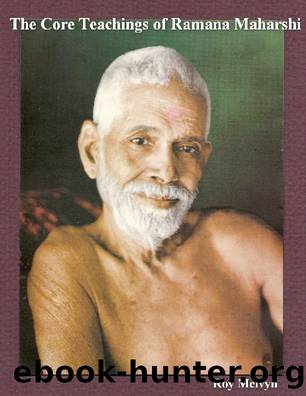The Core Teachings of Ramana Maharshi by Unknown

Author:Unknown
Language: eng
Format: epub
ISBN: 0000000000000
Published: 2021-10-25T04:39:58+00:00
Meditation and Mind
Q: I do not always concentrate on the same centre in the body. Sometimes I find it easier to concentrate on one centre and sometimes on another. And sometimes when I concentrate on one centre the thought of its own accord goes and fixes itself in another. Why is that?
RAMANA: It may be because of past practices of yours. But in any case it is immaterial on which centre you concentrate since the real Heart is in every centre and even outside the body. On whatever part of the body you may concentrate or on whatever external object, the Heart is there.
Q: Can one concentrate at one time on one centre and at another time on another or should one concentrate always consistently on the same centre?
RAMANA: As I have just said, there can be no harm wherever you concentrate, because concentration is only a means of giving up thoughts. Whatever the centre or object on which you concentrate, he who concentrates is always the same.
Q: What is dhyana [meditation]?
RAMANA: It is abiding as one's Self without swerving in any way from one's real nature and without feeling that one is meditating.
Q: What is the difference between dhyana and samadhi?
RAMANA: Dhyana is achieved through deliberate mental effort. In samadhi there is no such effort.
Q: What are the factors to be kept in view in dhyana?
RAMANA: It is important for one who is established in his Self [atmanishtha] to see that he does not swerve in the least from this absorption. By swerving from his true nature he may see before him bright effulgences, or hear unusual sounds, or regard as real the visions of gods appearing within or outside himself. He should not be deceived by these and forget himself.
Q: What is the difference between meditation [dhyana] and investigation [vichara]?
RAMANA: Both amount to the same. Those unfit for investigation must practise meditation. In meditation the aspirant forgetting himself meditates I am Brahman' or 'I am Siva' and by this method holds on to Brahman or Siva. This will ultimately end with the residual awareness of Brahman or Siva as being. He will then realise that this is pure being, that is, the Self.
He who engages in investigation starts by holding on to himself, and by asking himself 'Who am I?' the Self becomes clear to him.
Mentally imagining oneself to be the supreme reality, which shines as existence-consciousness-bliss, is meditation. Fixing the mind in the Self so that the unreal seed of delusion will die is enquiry.
Whoever meditates upon the Self in whatever bhava [mental image] attains it only in that image. Those peaceful ones who remain quiet without any such bhava attain the noble and unqualified state of kaivalya, the formless state of the Self.
Q: How is dhyana practised - with eyes open or closed?
RAMANA: It may be done either way. The point is that the mind must be introverted and kept active in its pursuit. Sometimes it happens that when the eyes are closed the latent thoughts rush forth with great vigour.
Download
This site does not store any files on its server. We only index and link to content provided by other sites. Please contact the content providers to delete copyright contents if any and email us, we'll remove relevant links or contents immediately.
| Clergy | Devotionals |
| Faith | Inspirational |
| Meditations | Monasticism & Asceticism |
| Prayer | Prayerbooks |
| Ritual | Sermons |
More Language of Letting Go: 366 New Daily Meditations by Melody Beattie(2456)
The Holy Spirit by Billy Graham(2430)
To Light a Sacred Flame by Silver RavenWolf(2360)
The Secret Power of Speaking God's Word by Joyce Meyer(2260)
Tuesdays With Morrie by Mitch Albom(2180)
The Lost Art of Good Conversation by Sakyong Mipham(2130)
The Traveler's Gift by Andy Andrews(2020)
Kundalini by Gopi Krishna(1830)
A Kingsbury Collection by Karen Kingsbury(1726)
Finding Chika by Mitch Albom(1650)
Angels of God: The Bible, the Church and the Heavenly Hosts by Mike Aquilina(1632)
As a Man Thinketh by James Allen(1583)
Angels by Billy Graham(1556)
The Yoga of Jesus: Understanding the Hidden Teachings of the Gospels by Paramahansa Yogananda(1534)
Curse Tablets and Binding Spells from the Ancient World by Gager John G.;(1517)
Barking to the Choir by Gregory Boyle(1509)
Autobiography of a Yogi (Complete Edition) by Yogananda Paramahansa(1492)
How To Be Born Again by Billy Graham(1408)
Anxious for Nothing by Max Lucado(1406)
